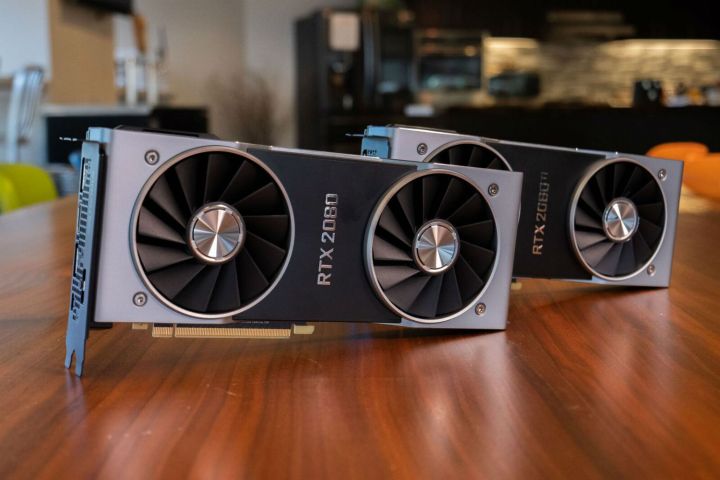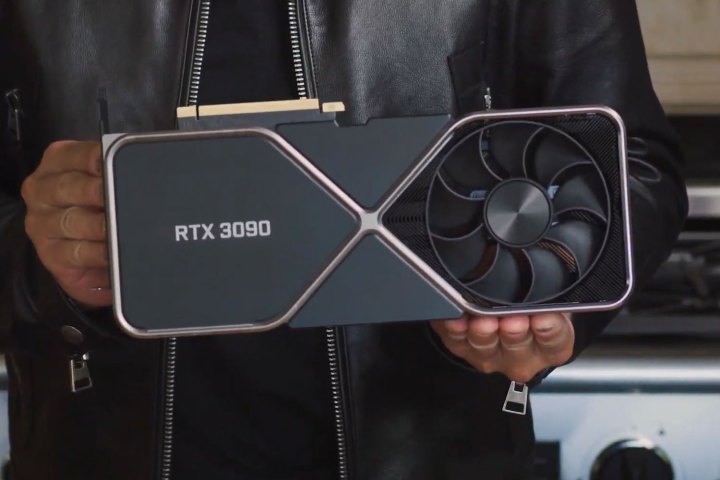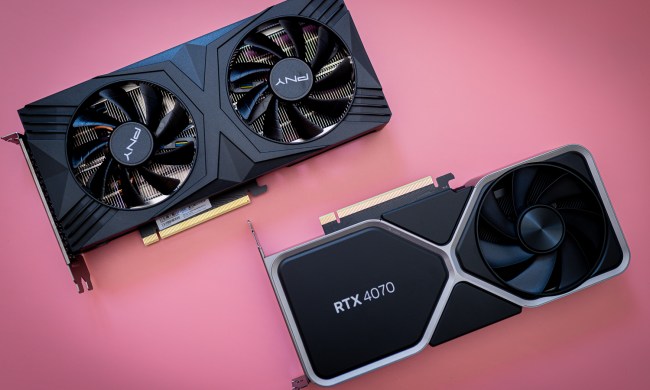Nvidia’s next-generation graphics cards have finally been officially unveiled, and if Nvidia’s own claims are anything to go by, they set new standards for power and performance. At the very top of the pile stands the new RTX 3090, a monstrous card that may be more Titan-like than Ti. But, as the most powerful graphics card Nvidia has ever made, comparisons to the last-generation kingpin are worth making.
When it comes to the best of the best, the 3090 and 2080 Ti are two (non) titans of the graphics card game, but how different are they, really? Is the 2080 Ti still worth buying if you can find it at a good price?
Pricing and availability

The RTX 2080 Ti originally released on September 28, 2018, priced at $1,199 for the Nvidia Founders Edition. The “Standard Edition,” which acted as a base for third-party cards, had a base price of $999, though Nvidia’s board partners typically added more capable cooling, greater clock speeds, and other features that raised the price to as much as $1,900 in extreme cases.
While technically still available, the 2080 Ti is no longer in production and stock is extremely limited. Some more expensive options are still available, and the secondhand market is likely to be extremely busy as RTX 3000 graphics cards become available, but finding a new 2080 Ti is not easy.
The RTX 3090 was unveiled on September 1, 2020, but isn’t on sale just yet. It will hit store shelves on September 24, with a price tag of $1,499. This is substantially more expensive than the original cost of the 2080 Ti, making it even more of a niche card. Still, it’s far more capable than the Titan RTX, which debuted at $2,500 just a couple of years ago, so if you want the best of the best, it might be a cost worth paying when it goes on sale.
Performance

Nvidia released some stark performance numbers for its RTX 3090 during its September press event, giving us our first idea of what the new-generation card can do. We also have some real-world performance results for the weaker 3080 from Digital Foundry that hint at the supreme power from the even-more-capable 3090. We’ll need to wait for third-party reviews to know for sure how capable the new flagship is compared to the RTX 2080 Ti, but Nvidia’s own first-party numbers and raw specifications for the two cards give us some idea of what to expect.
| RTX 3090 | RTX 2080 Ti | |
| GPU | GA102-300 | TU102-300-K1-A1 |
| Interface | PCIExpress 4.0 | PCIExpress 3.0 |
| CUDA cores | 10,496 | 4,352 |
| Tensor cores | TBD | 544 |
| RT cores | TBD | 68 |
| Base clock | 1,395MHz | 1,350MHz |
| Boost clock | 1,695MHz | 1,545MHz |
| Memory | 24GB GDDR6X | 11GB GDDR6 at 14Gbps |
| Memory speed | 19.5Gbps | 14Gps |
| Memory interface | 364-bit | 352-bit |
| Bandwidth | 936GBps | 616GBps |
| TDP | 350W | 260W |
The RTX 3090 has a staggering number of CUDA cores — over 10,000. On paper, that’s almost 2,000 more than the RTX 3080, and more than double that of the RTX 2080 Ti. That helps it output a total of 36 TFLOPs in shader performance, a nearly three-fold increase over the 2080 Ti’s 14.2 TFLOPs. While that sounds like it should mean the 3090 is more than twice as fast as the 2080 Ti, it’s not as simple as that.
The RTX 2080 Ti’s CUDA cores are all designed to handle floating-point (FP32) math, with a further (unlisted) 4,352 cores designed with integer math (INT32). These are both used by games in different ways but can only do the one job each. In comparison, the RTX 3090 has 5,238 FP32 CUDA cores, and 5,238 cores that can do either FP32 or INT32. That should mean that all of its cores are leveraged at the same time, but if those cores that can handle INT32 are used for INT32 in the same way as they are with the 2080 Ti, then the 3090’s performance improvement from core count increases may be more like 20%, rather than the 140% it might otherwise suggest.
With that in mind, there are other aspects of the 3090 that mean it will be significantly faster than the 2080 Ti. Its cores operate at a faster base and boost clock. It also has more than double the amount of memory with 24GB of next-generation GDDR6X, along with the wider memory bus that leads to a near 1GBps in memory bandwidth — a more than 50 percent increase over the 2080 Ti.
Nvidia claims that the 3070 is more capable than the 2080 Ti, so it’s no surprise that when Digital Foundry tested the RTX 3080 in a number of games (admittedly chosen by Nvidia), it recorded regular results of 60% to 90% performance improvement over an RTX 2080 — in 4K with ray tracing enabled and disabled. That would suggest that it could be as much as 40% faster than the 2080 Ti. Based on its CUDA core count and similar clock speed, the RTX 3090 could be 70% to 80% faster than the 2080 Ti — even more so in the right games.
We’ll need to wait for more detailed testing of the 3090 in a wider array of games at different detail settings, but it appears as if the 3090 will be substantially more capable than even the last generation’s best, especially in scenarios where it can leverage its switchable CUDA cores for a greater number of FP32 operations per second.
Where the 2080 Ti was designed as a 4K graphics card, Nvidia showed a demo where the 3090 has the power and performance to handle up to 8K resolution gaming at 60 FPS with ray tracing enabled. DLSS likely played a huge part in making this possible, and we’ll need to see this replicated in third-party sources before taking it as gospel, but it’s an impressive demonstration nonetheless.
If even remotely true, 100 FPS at 4K seems quite possible with the 3090.
Power and cooling
The 2080 Ti launched with what was, at the time, a revolutionary cooling design for Nvidia’s Founders Editions, debuting with a dual-fan configuration for the first time. Third-party alternatives were typically varied, with dual and triple fan variants, as well as some water cooling and hybrid cooling solutions.
Like most cards of its generation, the 2080 Ti leveraged dual eight-pin power connectors to handle its base 260W TDP. Heavily overclocked 2080 Tis could pull over 500W over three 8-pin connectors, though those were a rarity, even for such a high-end card.
The RTX 3090 uses Nvidia’s new push-pull vapor chamber design and a reconfigured PCB in a concave “V” shape that it pioneered with the RTX 3080 — it’s just much larger. The fins are bigger, the fans have longer blades, and the overall card itself is bigger, too. It measures 5.4-inches wide and 12.3-inches long (an inch wider and longer than the 3080) and could cause clearance issues in smaller cases because of it.
The big cooler makes it a three-slot design, too, though Nvidia promises that this new setup will help the card perform better at lower noise levels than previous-generation Titan GPUs, despite the higher power demands.

Third-party alternatives of the card have already been announced and the new shape of the PCB doesn’t seem to have perturbed typically long and chunky triple-fan designs, nor watercooled alternatives. Most do seem to feature a dual eight-pin power connector design, though, rather than the 12-pin. That may be limited to Nvidia’s Founders Editions.
Ray tracing, DLSS, and more
As with the launch of the RTX 2000 series graphics cards, Nvidia spent much of its press event for the new RTX 3000 series talking about ray tracing performance. Second-generation RT cores were said to offer up to 1.7 times the performance of Turing’s, allowing the new-generation RTX 3080 to handle 4K at 60 FPS with
The RTX 2080 Ti wasn’t capable of playing games at 4K with ray tracing enabled without frame rates being extremely poor, even with DLSS enabled. The 3090 looks to have fixed that problem.
Part of that advancement will be down to the general performance improvement of the 3090’s GPU core, so until we have third-party testing to confirm all aspects of the new card’s performance, we can’t say for sure just how capable its ray tracing ability will be. It is, however, much more capable than the 2080 Ti, making it the far better card for those wanting to play games at ultrahigh resolutions with
For a full list of games that support ray tracing, check out our guide.
The second generation of DLSS is a major component in Nvidia’s ray tracing and 4K gaming program, making the 3090 far more capable than it would be otherwise. It’s come a long way since the first generation, and though it’s not perfect, it should help give Nvidia the performance advantage at the top of the market when competing with AMD’s incoming Big Navi and RDNA 2 alternatives.
The RTX 3090 employs faster, second-generation tensor cores, too, allowing it to handle even more detailed sharpening and denoising tasks in real time, making for more detailed games, with less of a performance hit than we saw with the 2080 Ti.
The king is dead, long live the king

The most incredible of the last generation’s best isn’t that unique anymore, thanks to the 3080 and 3070 providing performance that exceeds what the 2080 Ti could do. Contrasting to that generation, the 3090 seems like a significant upgrade. We can’t provide you with proper statistics at the present moment, but we can assure you that preliminary analyses offer promising outlooks for unparalleled performance ratings that beat AMD and Nvidia products by a long shot.
The 3090 has a great power connector that will support HDMI 2.1, so you can display your game consoles in unbeatable quality. Its innovative internal fan technology has an effective and silent design that will safeguard your console against excessive heat without drowning out your audio. It’s even priced well below what a typical flagship (Titan-Esque) card would be, even if it’s far outside most gamer’s budgets.
Once it’s on the market, you’ll want to get the RTX 3090, so you can have the fastest 4K and 8K gaming, even if you have ray tracing enabled. While we can’t dispute the quality of the 2080 Ti card, it no longer stands out as we enter the new year.





